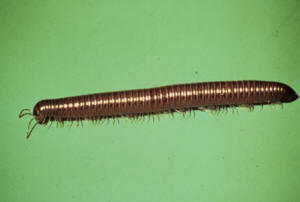|
COLUMN
 Freeze damage, fairy rings and millipedes Freeze damage, fairy rings and millipedes
By John
Fulton
 Send a link to a friend
Send a link to a friend
[April
24, 2014]
Freeze damage: I
mentioned freeze damage in the column last week. Now that some time
has passed, it is somewhat easier to assess damage — and take
corrective action. Damage may still appear worse than it is today,
but it won't improve any. The reason I say it may get worse is the
simple fact that brown leaves on broadleaf evergreens are still
attached to stems that have some life in them. If damage was severe
enough, the stems will also continue to die back a little further.
|
 Broadleaf evergreens — including boxwood, azalea, rhododendron,
holly and yew — probably took the last cold snap the worst. The
statement of fact is simple: Leaves that have turned brown will
not turn back green. There may be live buds yet on some of those
stems with some life in them, where the layer under the outside
is still green and pliable. In some cases there isn't any hope
for some of the branch tips, or even for some of the branches. Broadleaf evergreens — including boxwood, azalea, rhododendron,
holly and yew — probably took the last cold snap the worst. The
statement of fact is simple: Leaves that have turned brown will
not turn back green. There may be live buds yet on some of those
stems with some life in them, where the layer under the outside
is still green and pliable. In some cases there isn't any hope
for some of the branch tips, or even for some of the branches.
If there is still green under the dead area, you could always
prune or shear just under the dead area. This would get rid of
the dead material for the sake of appearance and also help spur
new growth. An added benefit would be thickening the remaining
shrub or tree. Entirely dead branches should be removed. After
removing these, and giving the haircut, you can assess what is
left. Then you can determine if you want to keep that — or start
over. Pruning this early in the season may lead to some "rank"
growth. This could be pruned again at the proper time in late
June.

Fairy rings
 Dark green grass in rings that look like a target pattern is
a symptom of fairy rings. Fairy rings are visible now. Fairy
rings are caused by a fungus that is in the soil. Actually there
are about 50 fungi that can cause fairy rings. These fungi feed
on decaying organic matter such as large roots from trees that
were in the area or from buried lumber. The dark green circle
part of the equation comes from extra nitrogen that becomes
available as the organic matter is broken down by the fungus. Dark green grass in rings that look like a target pattern is
a symptom of fairy rings. Fairy rings are visible now. Fairy
rings are caused by a fungus that is in the soil. Actually there
are about 50 fungi that can cause fairy rings. These fungi feed
on decaying organic matter such as large roots from trees that
were in the area or from buried lumber. The dark green circle
part of the equation comes from extra nitrogen that becomes
available as the organic matter is broken down by the fungus.
Some prevention will help keep the problem from occurring.
Simply removing stumps and large roots and not burying lumber
will help prevent this type of problem.
As for a cure, fungicide drenches have been successful on a
very limited basis. One option is to mask the symptoms of the
dark rings by fertilizing the surrounding grass with a
high-nitrogen fertilizer to make that grass green also.
Millipedes

What are millipedes? They belong to the arthropod class
Diplododa, which means double-footed. The reason is simple: They
have two legs per body segment. There are many different types
of millipedes — over 1,000 actually. They prefer to live in
moist places, such as under mulch, in flower beds, in
good-quality lawns and under wood. They feed on decaying organic
matter and occasionally on tender leaves or roots.
[to top of second column] |

Unlike centipedes, millipedes don't bite or sting. They do give off
a bad odor when disturbed or smashed. Be careful crushing them on
carpeting, as they can cause a stain.
If you're not sure whether you have millipedes or centipedes,
here are some differences: Centipedes have one leg per body segment,
while millipedes have two; centipedes normally have much longer legs
than millipedes; and centipedes move rapidly, while millipedes move
slowly.
Nonchemical controls aim at removing the moist resting places.
Dethatch your lawn to reduce that damp thatch layer just above the
soil surface; closely mow and edge the lawn to allow it to dry
quickly; remove debris that provides hiding places; pull mulch away
from the house; water grass in the early morning; and keep leaves
from piling up along the foundation.
If millipedes get inside the house, the vacuum cleaner is
probably the best control. It is nonchemical and prevents stains
from smashed millipedes. Other controls in the home include sticky
boards such as are used for mouse control, aerosol sprays that are
used for flying insects, and baseboard sprays used for ants.
Outside the house, start with a foundation spray such as propoxur,
permethrin or Sevin. Spray the foundation and the adjacent foot or
so of soil and plants or lawn. Make sure you treat doorways and
other openings as well. Since millipedes aren't insects to begin
with, don't expect complete control with a chemical spray program.
[By
JOHN FULTON,
University of Illinois
Extension director for Logan, Menard and Sangamon counties]

 |